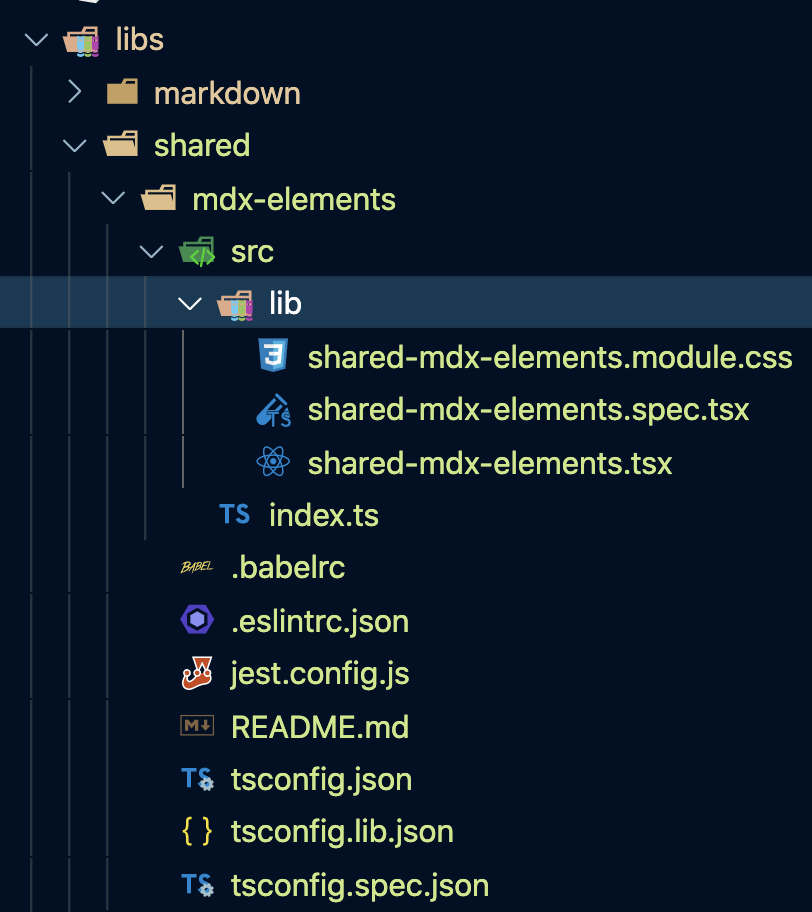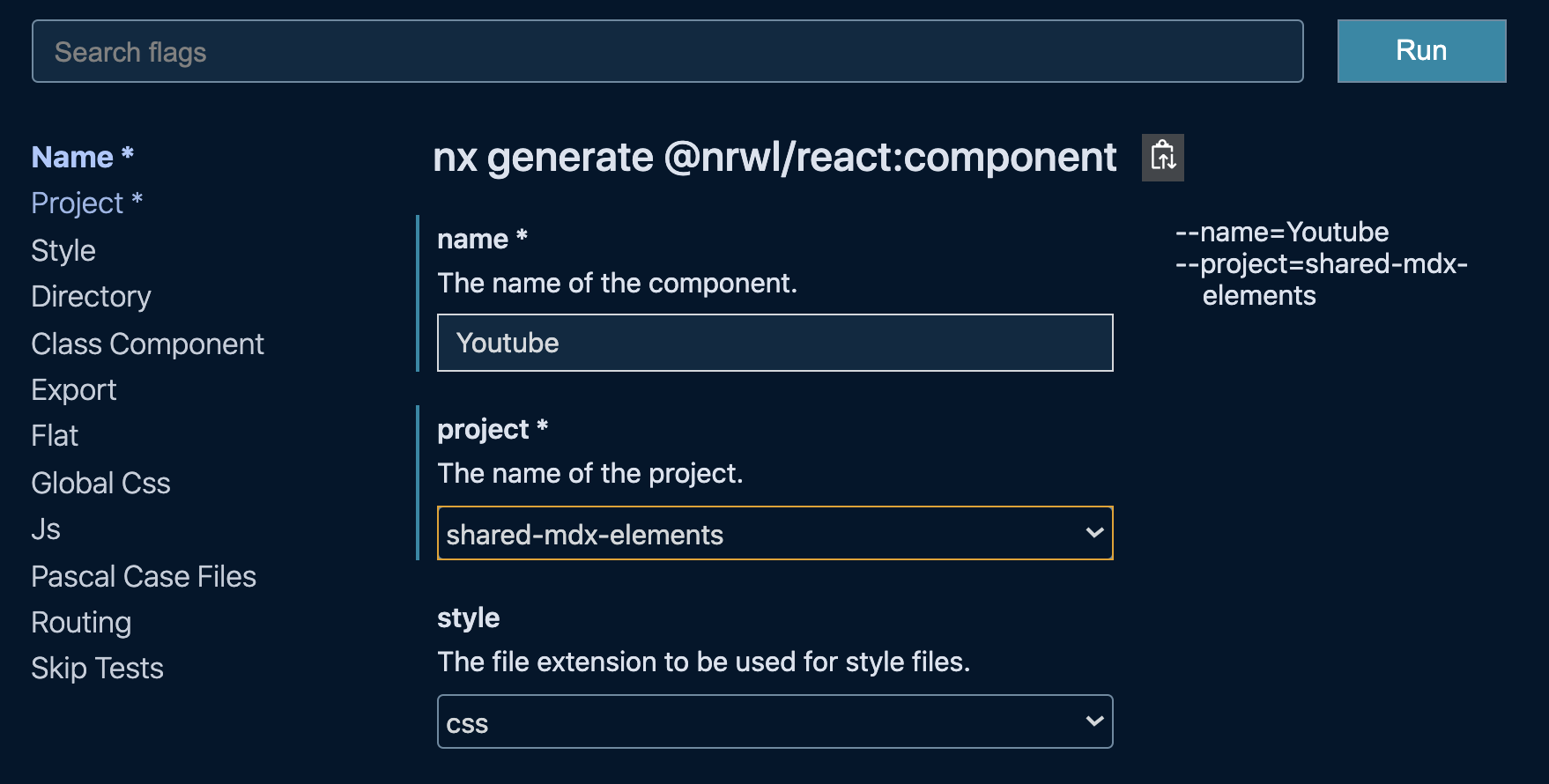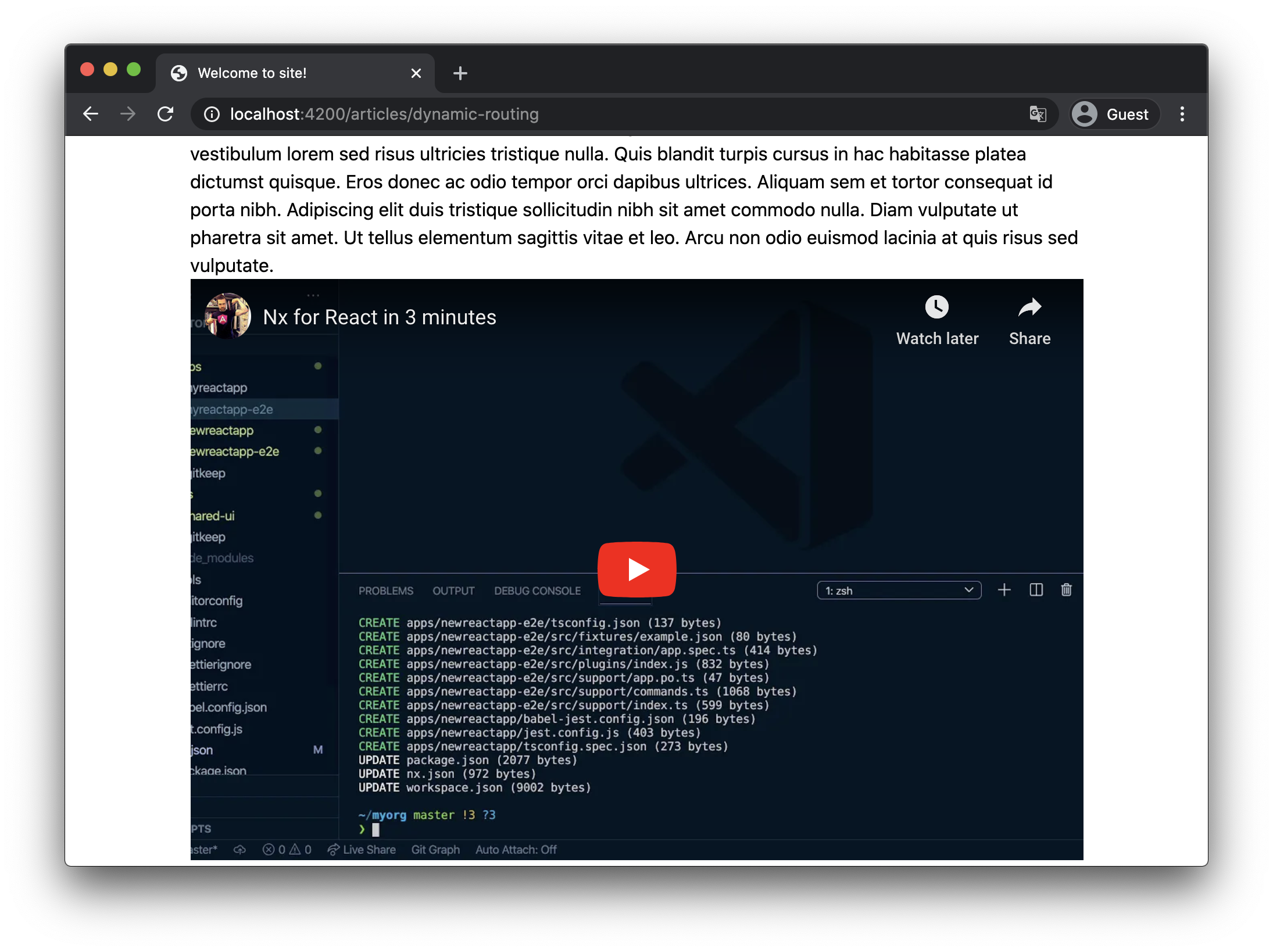Component hydration with MDX in Next.js and Nx


In the previous article, we explored how to render Markdown with Next.js as well as how Nx can help by moving the markdown-related processing logic into its own library. In this article, we’re going to explore how to dynamically hydrate React components with MDX and Next.js.
Building a blog with Next.js and Nx Series
This article is part of a series around building a blog with Nx, Next.js, Tailwind, Storybook and Cypress.
- Create a Next.js web app with Nx
- Setup Next.js to use Tailwind with Nx
- Read and render Markdown files with Next.js and Nx
- Component hydration with MDX in Next.js and Nx
- Hot Reload MDX changes in Next.js with Nx
- Using Nx Workspace generators to scaffold new blog posts
- Use Storybook with Tailwind in an Nx Workspace
- Use Cypress with Next.js and Nx to battle test your React Components
- Publishing a Next.js app to Vercel with Nx
Check back later, follow me on Twitter or subscribe to the Newsletter to get updates about upcoming articles
Markdown already gives a lot of flexibility in that you can use both, the Markdown syntax as well as plain HTML for links or embedded content. Many of the common static site generators such as Jekyll and Hugo (just to name a few), provide so-called “includes”. These are basically snippets or macros that get executed during the static site generation and usually produce a piece of HTML that gets embedded into the existing markdown rendered content. Take for instance the following Hugo snippet which allows to embed an Egghead.io video into a page.
<!-- egghead-lesson.html -->
<div class="egghead-video-embed">
<iframe src="https://egghead.io/{{ .Get "uid" }}/embed" width="100%" height="500px" loading="lazy"></iframe>
<a href="https://egghead.io/{{ .Get "uid" }}" class="external-link" data-client="eggheadio" data-uid="{{ .Get "uid" }}">View on Egghead.io</a>
</div>Within the markdown content, it can be used as follows:
## Styling Angular HTML Elements
This is a recent video lesson I created:
{ {<egghead-lesson uid="lessons/style-html-elements-in-angular-using-the-style-property" >}}If we want to implement something similar with Next.js, the closest we’d go with is probably MDX.
It basically is like JSX but allowing you to embed React components into a Markdown file.
Generate a Youtube Component
Let’s create a Youtube component that we can easily embed in our Markdown articles.
To host the code for our components we could simply create a folder “components” within the Next.js app siteto host all these reusable components. However, as we previously discussed, Nx recommends to move logic to the libs folder. Also, given these components are most probably highly reusable, and could also be used in other Next.js or React apps which might live in our Nx workspace (now or in the future), we’re going to create a Nx React library under the libs/shared folder.
npx nx g @nrwl/react:lib mdx-elements --directory=shared --style=cssNote, we use the
—directoryflag and passsharedto it because we want our new library to live within that subfolder. Using this flag allows you to futher structure your libs folder into some app specific features or components and more generally reusable ones.
This command should generate the following structure:

Note, apart from using Nx Console to visually construct these commands, you can also always append
--dry-runto see what the command would produce, without actually writing anything to the file system.
The Nx React library generator already adds a default component shared-mdx-elements. We can remove it as we’re not going to require it. That said, you can also directly append -no-component to the generator command to not have this default component generated.
We want to generate a new React component youtube into our mdx-elements library. Again we can use Nx.
Using Nx Console, we search for “React component”

And we fill in the necessary details into the form:

In the terminal you can also see the according command that would have led to the same result:
npx nx generate @nrwl/react:component --name=Youtube --project=shared-mdx-elements --no-interactive Finally, let’s implement the component.
// libs/shared/mdx-elements/src/lib/youtube/youtube.tsx
import './youtube.module.css';
export interface YoutubeProps {
title: string;
uid: string;
}
export function Youtube(props: YoutubeProps) {
return (
<div className="youtube-embed">
<iframe
src={`https://www.youtube.com/embed/${props.uid}`}
width="100%"
height="500px"
title={props.title}
></iframe>
</div>
);
}
export default Youtube;In addition, we create a new file mdx-elements.ts to group all the components we want to use within our MDX files and export them.
// libs/shared/mdx-elements/src/lib/mdx-elements.ts
import { Youtube } from './youtube/youtube';
export const mdxElements = {
Youtube,
};Note, you can also re-map the components, like
export const mdxElements = {
video: Youtube
}With this change, you basically created an “alias” and hence you could use <video...> in your markdown file rather than <Youtube ...>.
In order to be able to use our mdxEements and import it from within other JavaScript modules, we export them in the index.ts file of our library, which represents our public API for other libs and apps within our Nx workspace. We will need those mdxElements later in the article.
// libs/shared/mdx-elements/src/index.ts
export * from './lib/mdx-elements';With that, we can now import them in other components like
import { mdxElements } from '@juridev/shared/mdx-elements';Alright, our shared components we want to use within our Markdown files are ready now. But before being able to use them, we need to make a couple of changes to our current Markdown rendering implementation. Mainly we now need to make sure these embedded components get hydrated properly.
MDX options with Next.js
Now that we have a component to use in our MDX content, let’s actually implement the loading of MDX files with Next.js.
As of writing this article there are basically two options for using MDX with Next.js
@next/mdxnext-mdx-remote
From the official Next.js docs:
To use MDX with Next.js, your approach will differ based on your data source location. For local content, you can use the
@next/mdxpackage. This allows you to create pages directly with the.mdxextension inside your pages/ folder. For remote data, one option is to usenext-mdx-remote(a community project) to fetch your Markdown content inside getStaticProps / getStaticPaths.
In this article I’ll use next-mdx-remote, not necessarily because we’re loading it remotely but we have an _article folder outside our pages folder, which we want to load in our getStaticProps page.
Install dependencies
First of, let’s install a couple of libraries which we’re gonna need as we develop this new functionality.
yarn add next-mdx-remote
yarn add next-remote-watchRender MDX files to HTML
We don’t need to change anything in our GetStaticProps function in apps/site/pages/articles/[slug].txs . That’s because we previously extracted all markdown rendering logic into a dedicated library located in libs/markdown. That’s where the change is going to happen.
Open libs/markdown/src/lib/markdown.ts which is where we have our renderMarkdown function. Right now we’re calling markdownToHtml which lives in a separate file in our library that uses remark. We can delete libs/markdown/src/lib/markdownToHtml.ts entirely as we won’t need any more and remove the two packages from our dependencies:
yarn remove remark
yarn remove remark-htmlFurthermore, our renderMarkdown function is going to be very simple, by just importing the serialize function from next-mdx-remote/serialize and passing the content to it:
// libs/markdown/src/lib/markdown.ts
...
import { serialize } from 'next-mdx-remote/serialize';
...
export const renderMarkdown = (markdownContent: string) => {
return serialize(markdownContent || '');
};We also now don’t return HTML anymore, but rather a MDXRemoteSerializeResult type. Let’s adjust the interface in types.ts
// libs/markdown/src/lib/types.ts
import { MDXRemoteSerializeResult } from 'next-mdx-remote';
...
export interface MarkdownRenderingResult {
frontMatter: FrontMatter;
html: MDXRemoteSerializeResult;
}Rehydrating components with MDX
Inside the React page component, we can then use that mdxSource (note that it gets exported as html inside props) to rehydrate the react components potentially present in the MDX content.
// apps/site/pages/articles/[slug].tsx
...
import { MDXRemote } from 'next-mdx-remote';
import { mdxElements } from '@juridev/shared/mdx-elements';
...
export function Article({ frontMatter, html }) {
return (
<div className="md:container md:mx-auto">
<article>
<h1 className="text-3xl font-bold hover:text-gray-700 pb-4">
{frontMatter.title}
</h1>
<div>by {frontMatter.author.name}</div>
<hr />
<MDXRemote {...html} components={mdxElements} />
</article>
</div>
);
}Note the MDXRemote component we now use to embed the content into our page as well as the components we pass to the MDXRemote which are those we want to have hydrated.
To finally see the hydrated component, let’s rename our *.md files to *.mdx which is the usual extension you’d use for MDX files. By doing that we also need to make sure to change the file extensions in
libs/markdown/src/lib/markdown.ts:getParsedFileContentBySlugfunction which currently reads the posts by searching for justmdfiles.const postFilePath = join(postsPath, ${slug}.mdx);apps/site/pages/articles/[slug].tsx:getStaticPathswhere we clean the file extension. We should change it to.map((path) => path.replace(/\.mdx?$/, ''))
Finally, we should now be able to use the Youtube component we initially created in our _articles/dynamic-content.mdx file.
---
title: 'Dynamic Routing and Static Generation'
excerpt: 'Lorem ipsum dolor sit amet, consectetur adipiscing elit, sed do eiusmod tempor incididunt ut labore et dolore magna aliqua. Praesent elementum facilisis leo vel fringilla est ullamcorper eget. At imperdiet dui accumsan sit amet nulla facilities morbi tempus.'
date: '2020-03-16T05:35:07.322Z'
author:
name: JJ Kasper
---
Lorem ipsum dolor sit amet, consectetur adipiscing elit, sed do eiusmod tempor incididunt ut labore et dolore magna aliqua. Praesent elementum facilisis leo vel ...
<Youtube uid="9nDjLYXBCYM" title="Nx for React in under 3 minutes" />Running our blog should now properly embed the Youtube video:

Interesting next-mdx-remote and Next.js features
Dynamic loading of components
Next.js also supports dynamic loading of components, using the dynamic function
import dynamic from 'next/dynamic'In our libs/shared/mdx-elements/src/lib/mdx-elements.ts we could rewrite our import to use the dynamic loading feature
import dynamic from 'next/dynamic';
// import { Youtube } from './youtube/youtube';
export const mdxElements = {
Youtube: dynamic(() => import('./youtube/youtube')),
};This GitHub example from the official docs explains how this could be used together with next-mdx-remote to conditionally load heavy components, only when they are present in the Markdown. This is really handy when you have components loaded on just some pages and you wouldn’t want to instantiate them always again, but rather just when they’re used.
// https://github.com/vercel/next.js/tree/canary/examples/with-mdx-remote
import dynamic from 'next/dynamic'
import Test from '../components/test'
const SomeHeavyComponent = dynamic(() => import('SomeHeavyComponent'))
const defaultComponents = { Test }
export function SomePage({ mdxSource, componentNames }) {
const components = {
...defaultComponents,
SomeHeavyComponent: componentNames.includes('SomeHeavyComponent')
? SomeHeavyComponent
: null,
}
return <MDXRemote {...mdxSource} components={components} />
}Overriding existing HTML elements
Not only can we define new elements, but we can also override existing HTML elements. That way, for instance, we could override all links (<a> tags) on the page to add custom behavior to them. Let’s try.
First we create a new component which we can generate again:
npx nx generate @nrwl/react:component --name=CustomLink --project=shared-mdx-elements --style=cssAnd we implement it as follows:
// libs/shared/mdx-elements/src/lib/custom-link/custom-link.tsx
import Link from 'next/link';
import './custom-link.module.css';
export interface CustomLinkProps {
as: string;
href: string;
}
export function CustomLink({ as, href, ...otherProps }: CustomLinkProps) {
return (
<Link as={as} href={href}>
<a {...otherProps} />
</Link>
);
}
export default CustomLink;Again in the mdx-elements.tsx we map it:
import { MdxRemote } from 'next-mdx-remote/types';
import dynamic from 'next/dynamic';
import { CustomLink } from './custom-link/custom-link';
export const mdxElements: MdxRemote.Components = {
a: CustomLink,
Youtube: dynamic(() => import('./youtube/youtube')),
};As a result, for every <a> tag in the rendered HTML, our custom CustomLink React component will be instantiated and will allow us to manipulate the logic. Obviously, this also works with any other HTML element.
Conclusion
In this article, we learned:
- About the various MDX options we have with Next.js
- How to use Nx to generate a React library in our workspace as well as React components
- How to organize our components and export them s.t. they can be consumed from our Next.js application
- How to adjust the markdown rendering to add MDX support
See also:
- https://nextjs.org/blog/markdown
- https://github.com/vercel/next.js/tree/canary/examples/with-mdx-remote
GitHub repository
All the sources for this article can be found in this GitHub repository’s branch: https://github.com/juristr/blog-series-nextjs-nx/tree/04-dynamic-markdown-mdx